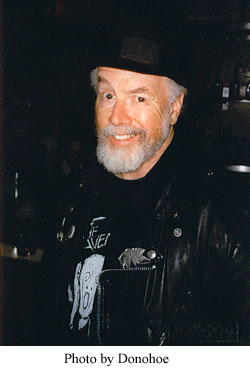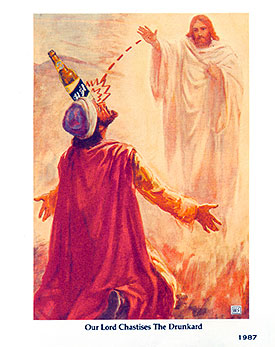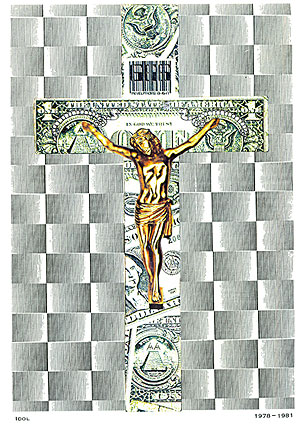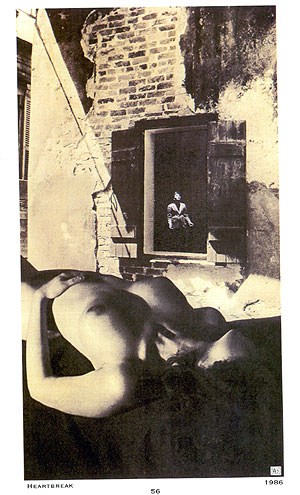Winston Smith
 Winston Smith first got notoriety doing punk rock fliers in the 70's and 80's, often for bands that did not exist. Fame came later when his montage style caught the eye of Dead Kennedys front man Jello Biafra. Soon the Dead Kennedys and Winston formed a productive partnership with Winston not only designing album covers for the seminal San Francisco punk band, but even their "DK" logo that would get pressed into stickers and skate board designs all across America's hardcore ghetto. To this day Winston hasn't been recompensed for the proliferation of his imagery by style pirates, but he doesn't worry too much about it. In the mid-eighties Winston's art became notorious when his cover for the Dead Kennedys' In God We Trust Inc. was deemed sacrilegious in England, and seized by an archaic and seldom employed anti-heresy law. In the United States televangelist (and self-appointed US foreign policy advisor) Pat Robertson denounced the same on his religious television program holding the offending album up for his viewers. The controversy of the album revolved around the portrayal of a gold Jesus on a cross of money, underlining how big religion is often big business with goals no more noble than any other for profit operation. While many took offense the album, and the artwork, called to mind the political power that organized religion, in particular the religious right, has always sought after. If faith plays politics doesn't it stand to reason that faith should also be subject to the same kind of scrutiny, and the same kind of satire, that regular politics is always subject to? Isn't this especially true when the men who hold high religious offices, regardless of the traditions that they support and are supported by, are still fallible men. Winston Smith's artwork has never shyed behind controversy and, in fact, has always dived right in, like the best of punk rock culture. Winston's relationship with Biafra lasted well past the band's demise with our man continuing to design cover art for various underground industrial, punk and rock bands to be pressed on the Alternative Tentacles record label. In the nineties he put out an art book featuring his work from the eighties called Act Like Nothing's Wrong. Winston's always provocative art migrated from the underground to the overground with Winston Smith artwork adorning that venerable establishment magazine, The New Yorker, in the early millinneum. Recently Winston has turned his hand to surf board design. I talked with Winston Smith about coming of age in the Italy of the Sixties.
Winston Smith first got notoriety doing punk rock fliers in the 70's and 80's, often for bands that did not exist. Fame came later when his montage style caught the eye of Dead Kennedys front man Jello Biafra. Soon the Dead Kennedys and Winston formed a productive partnership with Winston not only designing album covers for the seminal San Francisco punk band, but even their "DK" logo that would get pressed into stickers and skate board designs all across America's hardcore ghetto. To this day Winston hasn't been recompensed for the proliferation of his imagery by style pirates, but he doesn't worry too much about it. In the mid-eighties Winston's art became notorious when his cover for the Dead Kennedys' In God We Trust Inc. was deemed sacrilegious in England, and seized by an archaic and seldom employed anti-heresy law. In the United States televangelist (and self-appointed US foreign policy advisor) Pat Robertson denounced the same on his religious television program holding the offending album up for his viewers. The controversy of the album revolved around the portrayal of a gold Jesus on a cross of money, underlining how big religion is often big business with goals no more noble than any other for profit operation. While many took offense the album, and the artwork, called to mind the political power that organized religion, in particular the religious right, has always sought after. If faith plays politics doesn't it stand to reason that faith should also be subject to the same kind of scrutiny, and the same kind of satire, that regular politics is always subject to? Isn't this especially true when the men who hold high religious offices, regardless of the traditions that they support and are supported by, are still fallible men. Winston Smith's artwork has never shyed behind controversy and, in fact, has always dived right in, like the best of punk rock culture. Winston's relationship with Biafra lasted well past the band's demise with our man continuing to design cover art for various underground industrial, punk and rock bands to be pressed on the Alternative Tentacles record label. In the nineties he put out an art book featuring his work from the eighties called Act Like Nothing's Wrong. Winston's always provocative art migrated from the underground to the overground with Winston Smith artwork adorning that venerable establishment magazine, The New Yorker, in the early millinneum. Recently Winston has turned his hand to surf board design. I talked with Winston Smith about coming of age in the Italy of the Sixties.WS: My life isn't so busy, it's just that I am abysmally disorganized and hopelessly behind in all my obligations.
S: Of course in my airtight lifestyle and streamlined system of management I have absolutely no idea what you're talking about. I was wondering though what was art school in Italy like during the 60's? This was the era of Fellinni, the Red Brigade and the student strike in Paris. How was social revolt different over there from here?
WS: I could probably write a novel about that (and it has often been suggested that I do) but I'll try to boil it down to a short answer; Art School, such as it was, was largely wasted on me. I was 17 when I left America to go off to study art in Florence, Italy. This was in the late sixties and well before Italy had been "discovered" as a tourist destination. Compared to how it was back then, these days Italy looks like it's had a head-on collision between an overcrowded day at Coney Island and New Year's Eve in Times Square, just to give you a picture of how over-populated, over-crowded and over-priced it has become in the intervening years.
 Florence was a small town. You'd always see the same
people walking around and it was entirely possible to
stroll across the Ponte Vecchio or through the Piazza della Signoria or across the steps of the Duomo without seeing another living soul. Unfortunately that's no longer the case. Boatloads of Japanese, German and American tourists swarm all through the city at all hours and on every day of the year. So the city I grew up in and came of age in is no longer in existence. All the old world charm, grace and tranquility has been washed away, truly "gone with the wind". And now it's replaced with glaring lights and booming techno music blaring from every window and door, along with neon lights flogging every chain store retail outlet you could find in any shopping mall in middle America (Footlocker, the Disney Store, the Gap, etc.) For the love of acquiring tourist money the Florentines have altered, and in some cases, obliterated their own unique culture in order to cater to the foreigners that sustain them. Now it's a like a Disneyland ride, only with better food and cheaper wine.
Florence was a small town. You'd always see the same
people walking around and it was entirely possible to
stroll across the Ponte Vecchio or through the Piazza della Signoria or across the steps of the Duomo without seeing another living soul. Unfortunately that's no longer the case. Boatloads of Japanese, German and American tourists swarm all through the city at all hours and on every day of the year. So the city I grew up in and came of age in is no longer in existence. All the old world charm, grace and tranquility has been washed away, truly "gone with the wind". And now it's replaced with glaring lights and booming techno music blaring from every window and door, along with neon lights flogging every chain store retail outlet you could find in any shopping mall in middle America (Footlocker, the Disney Store, the Gap, etc.) For the love of acquiring tourist money the Florentines have altered, and in some cases, obliterated their own unique culture in order to cater to the foreigners that sustain them. Now it's a like a Disneyland ride, only with better food and cheaper wine.
I reckon I was lucky to live there in the period I did since it was just before the introduction of modern television and global mass marketing, when the tenor of life moved more slowly and people had time for one another. Now I sound like some old geezer talking about the "good old days" but that is exactly how it was. The contrast between the period I lived there and the present day (though it was only 35 years ago) might as well be a century, what with all the technological advances and their inevitable damaging affect on the society and people's personal behavior and attitudes.
S: You took art instruction there. Could you tell me about that?
WS: I went to the Accademia di Belli Arti, the Academy of Fine Arts which was first established my Lorenzo the Magnificent back in the fifteenth century Michelangelo Buonarroti was an alumni. But the tuition for the year at that time was 6,000 (approximately ten dollars). Sounds very impressive, doesn't it? But "you get what you pay for" as the saying goes. The masters almost never came to class and their assistants were next to useless when it came to art instruction. So I taught myself for the most part just by walking about in town and making drawings of the masterpieces I found on every corner. Every day I would spend several hours in the museums and gothic churches, sketching the work of Botticelli, Leonardo, Giotto, Lorenzetti and countless others. I still have dozens of sketch books from that period. So by and by, I just remained in Italy for the next several years. After all, at that time it was one quarter the cost of living that people had to contend with in the US. Plus I was surrounded by the most wonderful artwork, the most beautiful women, the most exquisite food and the best wine in the world.
 And yes, even though by the mid seventies Italy was going through a bad case of the sixties, it was still worth all the risk and upheaval to live through that experience at that time. I only feel sorry for anyone who didn't get to experience it. Government corruption, the Red Brigades, student revolts and fighting in the street with armed police battalions were all part of the kaleidoscope of life. Riots, shortages, constant strikes, bombed trains and civil unrest. I still preferred that to what I had come from. It was a strong antidote to the relative "eventlessness" of life on the Great Planes.
And yes, even though by the mid seventies Italy was going through a bad case of the sixties, it was still worth all the risk and upheaval to live through that experience at that time. I only feel sorry for anyone who didn't get to experience it. Government corruption, the Red Brigades, student revolts and fighting in the street with armed police battalions were all part of the kaleidoscope of life. Riots, shortages, constant strikes, bombed trains and civil unrest. I still preferred that to what I had come from. It was a strong antidote to the relative "eventlessness" of life on the Great Planes.
S: Could you elaborate on Midwestern boredom?
WS: Well even the mere physical differences between the flat, barren wasteland of Oklahoma (a place even the American Indians never would've chosen to settle permanently until the Anglo-Americans force-marched them all there in the mid nineteenth century) and the gentle, rolling hills of Tuscany was astonishing. That much alone would have been worth the move. Plus, as a boy of 17 I quite relished the opportunity to live on my own. And as I didn't actually have much of a home-life (my folks were always gone while I was growing up) I never had the least wish to return to what had previously felt like 16 years of solitary confinement and sensory deprivation. It was the best thing I could have done at the time and I've never regretted the turn my life took after that.
The culture shock I experienced upon my return to America in 1976 was overwhelming. I felt like Rip Van Winkle. This country was almost unrecognizable from the world I left in the late sixties. There were no more protests, no fighting in the streets, the War in Viet Nam was lost and finished and the ease of landing a well-paying job had vanished with the "Energy Crunch" hype that permeated the nation. Surveillance cameras were suddenly EVERYwhere and no one seemed to object. Unemployment had skyrocketed and transnational corporations became the new dominant feature in the economy, constituting a hidden government, unelected and unaccountable.
I felt like I had been drop-kicked into a twisted dystopia where the formerly courageous citizenry had been rendered docile and politically spineless by constant stimulus overload and non-stop television that turned their creative and intuitive faculties to tapioca. I actually don't think I'm overstating the case. Naturally such things were more evident to someone who'd been outside the country for that long. (I since found out that some people thought I'd been in prison during that time because I had no idea who Mork & Mindy were or what Sesame Street was and had never heard of Saturday Night Live or the Waltons. (I'm so glad I didn't, too. It would have been worth being in prison just to avoid all that rubbish).
 After living in Boston for a while (working in an area that used to be known as the "Combat Zone") I hitch-hiked across the country down rout 66 and wound up in San Francisco. Back in Italy I'd worked as a roadie for a Band with RCA Italiana so when I got here that was THE only job I could do that I'd had any experience with. I worked as a "rent-a-roadie" for various Bay Area bands like Santana, Crosby, Stills & Nash, Journey, Quicksilver Messenger Service, the Tubes and many others to obscure to mention.
After living in Boston for a while (working in an area that used to be known as the "Combat Zone") I hitch-hiked across the country down rout 66 and wound up in San Francisco. Back in Italy I'd worked as a roadie for a Band with RCA Italiana so when I got here that was THE only job I could do that I'd had any experience with. I worked as a "rent-a-roadie" for various Bay Area bands like Santana, Crosby, Stills & Nash, Journey, Quicksilver Messenger Service, the Tubes and many others to obscure to mention.
S: When did you discover punk or, rather, when did punk discover you?
WS: It was right about that time that Punk reared its ugly head and I realized this is what I'd been waiting for all my life. Sounds like a cheesy cliché' but the sheer raw energy and pounding intensity of live punk rock was the perfect antidote to the hopelessness and mediocrity that our society was steeped in at that time. I believe this is why the punk movement, both in music and art, has endured over the last three decades and not fizzled out like the hippy-dippy, peace, love and brown rice scene of the sixties did. That whole movement was so quickly embraced and then co-opted by the Establishment (ha! THAT'S an archaic expression you never hear anyone say any more...) that the driving, life force became overwhelmed by commercialization and mainstream hype.
 To be fair, there are of course still countless individuals
and groups who continue on in the clear principals and hope
of Peace and Harmony
exemplified by that era's music and art and literature.
And in reality
these people who remained true to the core ideals of that
era actually have more in common with the core beliefs of
what Punk stood for (at least at its inception) than the
rest of our society (which tends to want to regard things
like social movements and other cultural phenomena up into separate parts, the easier to label and then dismiss them.
To be fair, there are of course still countless individuals
and groups who continue on in the clear principals and hope
of Peace and Harmony
exemplified by that era's music and art and literature.
And in reality
these people who remained true to the core ideals of that
era actually have more in common with the core beliefs of
what Punk stood for (at least at its inception) than the
rest of our society (which tends to want to regard things
like social movements and other cultural phenomena up into separate parts, the easier to label and then dismiss them.
Over & Out.
Winston